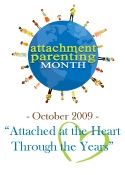I like that I have a constant reminder with API of the “I” in AP. Let me explain.
I have a hard time slowing down. There are so many things that “need” to be done and I am constantly wondering if I am doing the best for my child, if we are spending enough time together (pretty silly for a SAHM don’t you think? But you are getting an inside look at my crazy mind). I have even wondered if I wasn’t doing a good enough job because I don’t have scheduled play times. There always seems to be something that I can beat myself up about or worry that I am not doing well enough or something else that needs to be done. There is a never ending supply of things to clean, organize, pick up. etc. And then since we have made the choice to AP, my son’s needs and even many of his wants come before chores. We have set it up that way.
And where does this leave the “I”? I have noticed that if I do not take the time for the “I” that the AP does not happen very well. If I don’t take time to do some things for me, if I don’t take the time to “take care of myself” then very quickly AP becomes a difficulty instead of a joy.
SO, I have made a short list today of “I” things that need to happen for me to be “OK”, now these don’t have to happen every day, though I do better if some of them happen either every day or every few days. These things vary for every one of us this is just my “I” list, it is in no particular order.
1. I need a date with hubby alone once a month.
2. I need to exercise.
3. I need to write.
4. I need to read.
5. I need to have sex.
6. I need to eat (healthy).
7. I need some me alone time.
8. I need a clean house.
These are some of the more important things that I could come up with. Now these do not involve my mini man, not because he is not important but because these things need to happen so that I can be fully present and enjoy the togetherness that we get to share every day.
Now I know that it might be daunting to try to find time for any of this. But I have found out a few things that work for me to ensure that I get some of this time.
- Do not use nap time to run around doing a bunch of different things. Pick a cleaning or organizing or laundry project, get it started or finish it up, make sure it isn’t a huge job, and then spend some time doing on of the “I” items.
- Stay up later. My hubby has a very early morning job so he ends up going to bed early, I spend some time with him before he goes to sleep and then I stay up for an hour or to doing the “I” items.
- Have hubby put the little one to bed. This works out great for us so that I can make sure and get some exercise time.
- We set a date night and stick with it.
These are just a few things, mostly to be able to spark some of your own creativity. I know that it can be difficult, I am sure even more so with more children! But it is essential that as we read the articles at API that we remember that without an “I” there is no AP.


 Happy
Happy 